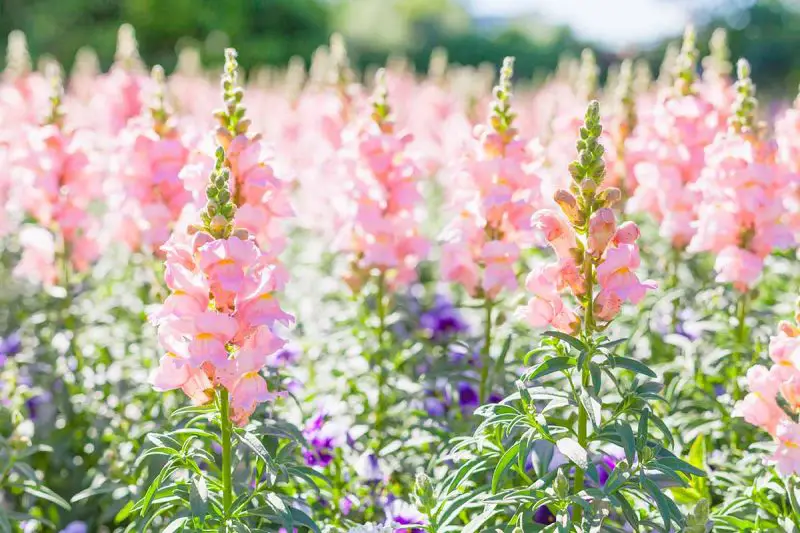Snapdragons are one of the most beloved garden flowers worldwide, known for their vibrant colors and unique, dragon-shaped blooms. They bring charm to flower beds, borders, and containers, instantly brightening any garden space. With the right care, snapdragons can bloom for months, rewarding gardeners with a continuous display of lively colors. Understanding their growth requirements is essential for keeping them healthy and productive. Proper attention to sunlight, soil, watering, and pruning ensures that snapdragons not only survive but thrive, creating a garden that is both beautiful and resilient.
Unlike many other annual flowers, snapdragons offer versatility in planting seasons and design choices. They can adapt to cooler spring temperatures and even tolerate light frost, making them a favorite among gardeners looking to extend the blooming season. By learning specific care techniques and avoiding common mistakes, anyone can enjoy the stunning, long-lasting flowers that snapdragons provide. This guide explores proven strategies, from planting and fertilizing to pest control and overwintering, ensuring your snapdragons remain a vibrant highlight in your garden all year long.
Table of Contents
ToggleUnderstanding Snapdragon Bloom Cycle

Snapdragons have a unique bloom cycle that influences care and maintenance. Flowers typically appear in early spring for cool-season varieties and continue until late fall in mild climates. Each spike produces multiple blooms, opening sequentially from bottom to top. This pattern allows gardeners to enjoy flowers over an extended period rather than all at once. Understanding this growth cycle helps plan watering, fertilizing, and pruning schedules effectively. Gardeners who observe bloom timing can intervene at the right moments, ensuring continuous flowering and vibrant displays.
Different snapdragon varieties may have distinct blooming habits. Dwarf types usually flower earlier and remain compact, making them ideal for containers, window boxes, and garden borders. Taller varieties produce long, dramatic spikes with numerous blooms but may require staking to prevent bending or breaking. Some varieties are bred specifically for repeated flowering, allowing gardeners to enjoy multiple bloom cycles within a single season. Choosing the right variety based on desired bloom timing and garden placement ensures consistent color throughout spring and fall.
Environmental factors strongly influence the bloom cycle. Temperature, sunlight, soil fertility, and moisture all affect flower initiation and longevity. Cool weather generally promotes longer-lasting blooms, while prolonged heat may cause premature wilting. Deadheading spent flowers encourages new growth, extending the flowering period and improving plant vigor. Additionally, fertilizing with a phosphorus-rich formula supports robust flower production, aligning with the natural bloom cycle. By understanding how snapdragons grow and flower, gardeners can anticipate peak bloom times, adjust care routines, and maintain a vibrant, long-lasting garden display from early spring to late autumn.
Choosing the Right Location and Soil
Selecting the perfect location is the first step in growing healthy snapdragons. These flowers thrive in full sun, receiving at least six hours of direct sunlight daily. In hotter climates, partial afternoon shade helps prevent wilting and stress. Adequate sunlight ensures strong stems, vibrant blooms, and overall plant vigor. Gardeners should avoid planting snapdragons in low-light areas, as insufficient sunlight leads to weak growth and fewer flowers. Choosing a location with good air circulation also reduces disease risks, such as powdery mildew and rust. Proper placement sets the foundation for a long-lasting, colorful display in the garden.
Soil preparation plays an equally important role in snapdragon health. Well-draining soil prevents waterlogging, which can cause root rot and stunted growth. Before planting, loosen the soil to at least twelve inches deep and incorporate organic matter like compost or aged manure. This improves nutrient availability, retains moisture, and encourages strong root development. Snapdragons prefer slightly acidic to neutral soil, with a pH between 6.2 and 7.0. Conducting a soil test helps gardeners adjust pH levels using lime or sulfur, creating optimal growing conditions for lasting blooms.
Gardeners should also consider companion plants when choosing snapdragon locations. Avoid overcrowding with tall or aggressive plants that may shade snapdragons or compete for nutrients. Low-growing groundcovers or other sun-loving flowers make excellent companions, enhancing both aesthetics and plant health. Proper spacing ensures airflow around each plant, reducing fungal disease risks and promoting uniform growth. By carefully selecting the right location and preparing nutrient-rich, well-draining soil, gardeners set snapdragons up for a season filled with strong stems, vibrant flowers, and continuous blooms.
Watering and Fertilizing Snapdragons
Proper Watering Techniques
Snapdragons require consistent moisture to thrive, especially during active growth and flowering. Soil should remain evenly moist but never waterlogged. Overwatering can cause root rot and yellowing leaves, while underwatering leads to wilting and reduced blooms. Watering at the base of plants keeps foliage dry and reduces the risk of fungal diseases. Early morning irrigation is ideal, allowing soil to absorb moisture before heat intensifies. Mulching around the roots helps retain moisture and prevents rapid evaporation, creating a more stable root environment.
Monitoring soil moisture regularly ensures snapdragons receive adequate hydration. Container plants may need more frequent watering than garden beds. Adjust watering frequency based on seasonal weather conditions, increasing during hot, dry periods and reducing during rain. Avoid overhead watering during evening hours, which can encourage fungal infections. Consistent and careful watering supports healthy root development, robust stems, and vibrant flowers. Proper watering lays the foundation for long-lasting blooms, creating a resilient, visually appealing garden display that can flourish throughout the season.
Fertilizing for Continuous Blooms
Fertilizing snapdragons promotes healthy growth and prolonged flowering. A balanced, slow-release fertilizer supports root development, strong stems, and abundant blooms. Fertilization every four to six weeks during the growing season ensures nutrients are available when plants need them most. Organic alternatives, such as compost tea or well-rotted manure, provide essential nutrients and improve soil structure. Supplemental feeding with a liquid fertilizer during bloom periods encourages peak flower production.
Avoid over-fertilizing, which can result in excessive foliage growth at the expense of flowers. Focus on phosphorus-rich formulas to encourage robust bloom production. Fertilizing after deadheading or pruning supports new growth and additional flowering cycles. Observing plant response allows adjustments in fertilizer type and frequency. By following proper fertilization practices, gardeners can maintain vibrant snapdragons that bloom continuously, enhancing the garden’s color and texture throughout the season while promoting strong, resilient plants.
Deadheading and Pruning for Continuous Blooms
Deadheading Snapdragons
Deadheading, or removing spent flowers, is essential for prolonging snapdragon blooms. Once flowers fade, pinching them off redirects the plant’s energy toward producing new buds. This simple practice prevents seed formation, which can slow or stop flowering. Regular deadheading encourages bushier growth and maintains a tidy appearance. It also reduces the risk of disease by eliminating decaying flowers that can attract pests or fungus. Removing old flowers improves air circulation around the remaining buds, helping plants stay healthy and vibrant.
Perform deadheading weekly during peak bloom season. Use clean fingers or small scissors to snip the spent flower just above the first set of healthy leaves. Avoid cutting too close to the main stem to prevent damage. Deadheading is especially important for taller varieties, which may produce multiple flower spikes simultaneously. By keeping up with this routine, gardeners stimulate continuous flowering, extending the garden’s vibrant color. Deadheading not only enhances visual appeal but also strengthens plant resilience, ensuring snapdragons remain productive and beautiful throughout the growing season.
Pruning for Strong Growth
Pruning snapdragons encourages new growth and more substantial flower production. Light pruning after the first bloom can trigger a second flowering cycle in late summer or early fall. Removing weak, damaged, or overcrowded stems improves air circulation and reduces disease risk. Proper pruning helps plants maintain a compact, attractive shape while supporting healthy root and stem development. Pruning also prevents plants from becoming too leggy, ensuring blooms appear evenly along the spikes.
Use sharp, clean tools to cut back tall or leggy stems. Pinch back young shoots to encourage bushier growth and more blooms. For taller varieties, staking and careful pruning prevent bending or breaking under the weight of flower spikes. Pruning can also involve trimming the base of older plants to rejuvenate them for the next season. By following consistent pruning practices, gardeners can enjoy a continuous display of vibrant, long-lasting snapdragon flowers while promoting strong, resilient plants that enhance the garden’s overall beauty and structure.
Seasonal Care
Spring Care for Snapdragons
Spring is the prime growing season for snapdragons. Begin by preparing the garden bed, removing debris, and lightly tilling the soil. Fertilize with a balanced, slow-release formula to encourage strong growth and early blooms. Inspect plants for pests such as aphids or slugs, which emerge as temperatures rise. Deadheading spent flowers from previous seasons promotes new growth and maintains a tidy appearance. Adding a thin layer of compost enriches the soil and improves drainage, supporting healthier roots.
Water consistently, keeping the soil evenly moist but not soggy. Mulching helps retain soil moisture, suppress weeds, and stabilize soil temperature. For young seedlings, provide light shade during unusually warm days to prevent stress. Spring care also includes staking taller varieties to prevent bending under their first blooms. Regular monitoring ensures early detection of disease, pests, or nutrient deficiencies. By following these steps, gardeners can establish snapdragons for vigorous growth, abundant flowers, and a long-lasting, vibrant season from the very beginning of spring.
Summer and Fall Care
During summer, snapdragons may face heat stress, which can shorten bloom life. Provide partial shade during the hottest part of the day in warmer regions to prevent wilting. Increase watering frequency but avoid overwatering, which can lead to root rot. Fertilize every four to six weeks with a phosphorus-rich formula to support continuous flowering during the peak bloom period. Regular deadheading encourages successive blooms and prolongs the season. Mulching during summer reduces soil moisture loss and keeps roots cool.
In fall, reduce fertilization as growth slows and prepare plants for colder temperatures. Light pruning can rejuvenate older stems and stimulate a second bloom in mild climates. Mulching with organic material protects roots from early frost and insulates the soil. Monitor for late-season pests and diseases, removing affected leaves promptly to prevent spread. By adjusting care according to seasonal needs, gardeners ensure snapdragons remain productive and vibrant from spring through late fall, providing consistent color and healthy growth throughout the year.
Protecting Snapdragons from Pests and Diseases
Common Pests and Their Management
Snapdragons are prone to several common garden pests, including aphids, spider mites, and caterpillars. These insects feed on leaves, stems, and buds, weakening plants and reducing flower production. Aphids cluster on young shoots, causing distortion and sticky residue. Spider mites thrive in hot, dry conditions and create fine webbing on leaves. Caterpillars can chew large holes in foliage and flowers. Early identification is crucial to prevent severe infestations and preserve plant health. Pests also attract secondary problems, like fungal growth on damaged leaves, making prevention essential.
Manual removal of pests is effective for small gardens. Gently wash off aphids with a strong stream of water or use insecticidal soap for larger infestations. Introduce beneficial insects, like ladybugs or predatory mites, to naturally control pest populations. Regularly inspecting plants, especially the undersides of leaves, allows gardeners to act before damage spreads. Maintaining healthy plants through proper watering, fertilization, and pruning strengthens natural resistance, reducing reliance on chemical treatments. Combining vigilant monitoring with preventive measures ensures snapdragons continue producing vibrant blooms throughout the season without severe pest interference.
Preventing Fungal and Bacterial Diseases
Snapdragons are susceptible to fungal and bacterial diseases, such as powdery mildew, rust, and crown rot. High humidity, poor air circulation, and excessive moisture contribute to outbreaks. Preventive measures focus on creating a favorable growing environment that discourages pathogen development. Proper spacing and pruning improve airflow and reduce leaf wetness. Avoid overhead watering, which promotes fungal growth. Mulching helps maintain consistent soil moisture and prevents soil-borne pathogens from splashing onto foliage. Diseased leaves must be removed promptly to avoid spreading infections.
Use disease-resistant snapdragon varieties when possible. Remove and destroy infected plant parts immediately to prevent spread. Crop rotation in vegetable or flower beds reduces soil-borne disease buildup. Fungicides can be applied when necessary, following instructions carefully to minimize harm to beneficial insects. Maintaining garden hygiene, monitoring plants regularly, and addressing minor issues early ensures snapdragons remain healthy and vigorous. Combining cultural, biological, and chemical strategies allows gardeners to enjoy long-lasting, vibrant blooms while minimizing the risk of disease throughout the growing season.
Common Mistakes to Avoid
Overwatering and Underwatering
One of the most common mistakes gardeners make with snapdragons is incorrect watering. Overwatering leads to root rot, yellowing leaves, and fungal diseases. Conversely, underwatering causes wilting, stunted growth, and reduced flower production. Both extremes stress the plant and shorten bloom duration. Newly planted snapdragons are especially sensitive and need consistent moisture until roots establish. Mulching helps stabilize soil moisture, reduces temperature fluctuations, and protects roots from stress. Monitoring soil regularly allows gardeners to detect dryness or waterlogging early.
Water at the base of the plant, avoiding wetting the foliage, which can promote fungal issues. Container plants dry faster than garden beds and require closer monitoring. Adjust watering frequency according to seasonal temperatures, rainfall, and soil type. Early morning irrigation allows soil to absorb moisture before heat intensifies, and deep watering encourages strong root growth. Proper watering promotes healthy stems, lush foliage, and vibrant blooms. Gardeners who master consistent watering will enjoy long-lasting, resilient snapdragons that produce abundant flowers throughout the season, even under variable weather conditions.
Neglecting Deadheading
Neglecting to deadhead spent blooms is another frequent mistake. When old flowers remain on the plant, energy diverts to seed production instead of creating new blooms. This reduces flower quantity, shortens the blooming period, and makes plants look untidy. Deadheading also improves air circulation around remaining buds, minimizing fungal disease risk. Removing old flowers prevents decay, which could attract pests or spread disease to healthy tissues.
Pinch off faded flowers just above the first set of healthy leaves using clean fingers or scissors. Regular weekly maintenance is sufficient for most varieties. Deadheading encourages additional flowering cycles, keeping snapdragons vibrant and productive. Combining deadheading with seasonal pruning ensures compact growth, stronger stems, and a visually appealing garden structure. Gardeners who maintain this habit benefit from longer-lasting blooms, continuous color in flower beds, and healthier plants that can survive varying weather conditions, making snapdragons a reliable and striking garden highlight year after year.
Ignoring Sunlight Requirements
Snapdragons require full sun for at least six hours per day to bloom profusely. Ignoring sunlight needs is a common mistake that weakens plants. Insufficient light results in leggy growth, fewer flowers, and pale or dull colors. Some gardeners place snapdragons in shaded areas, assuming they tolerate low light. While partial shade can help in very hot climates, consistent insufficient sun severely impacts plant health. Leggy plants are more prone to breakage and pest infestations. Proper sunlight is essential for energy production, which fuels blooms and strengthens stems.
To prevent problems, select planting locations that receive adequate sunlight. Observe daily sunlight patterns and avoid areas shaded by trees, walls, or buildings. Container-grown snapdragons can be moved to sunnier spots when needed. Rotate containers regularly to ensure all sides receive light. Adequate sunlight encourages compact growth, strong stems, and vibrant, long-lasting flowers. Gardeners should combine sunlight management with proper watering and fertilization for optimal results. By meeting snapdragons’ light requirements, gardeners ensure continuous flowering, healthy plants, and a visually appealing garden display throughout the season, making sun exposure a critical factor in successful snapdragon care.
Planting in Poor Soil
Planting snapdragons in poor or heavy clay soil is another frequent error. Soil that drains poorly leads to waterlogged roots, root rot, and nutrient deficiencies. Conversely, sandy soils may drain too quickly, causing drought stress. Both extremes stunt growth and limit flower production. Snapdragons thrive in well-draining, nutrient-rich soil with a slightly acidic to neutral pH. Preparing soil before planting ensures strong root systems, proper nutrient uptake, and vibrant flowers throughout the growing season. Neglecting soil quality often results in plants that appear healthy initially but fail to produce abundant blooms.
Improve soil by adding organic matter such as compost, aged manure, or leaf mold. Loosen compacted soil to allow roots to penetrate easily and retain moisture. Conduct a soil test to adjust pH if necessary, ensuring nutrients are readily available. Proper soil preparation reduces stress, prevents diseases, and supports long-lasting blooms. Gardeners who invest in soil quality provide snapdragons with a strong foundation for continuous flowering, strong stems, and an attractive, resilient garden display. Well-prepared soil ensures plants thrive even under variable weather, maximizing bloom duration and overall plant health.
Skipping Fertilization
A common mistake with snapdragons is skipping fertilization. Without regular feeding, plants may develop weak stems, pale foliage, and reduced bloom production. Snapdragons require balanced nutrients to maintain vigorous growth and vibrant flowers. Fertilization supports root development, strengthens stems, and promotes long-lasting blooms throughout the growing season. Nutrient deficiencies can lead to slow growth, small flowers, and susceptibility to pests and diseases.
Use a balanced, slow-release fertilizer every four to six weeks during the growing season. Organic options like compost tea or well-rotted manure can supplement soil nutrients. Avoid over-fertilization, which can encourage excessive foliage at the expense of flowers. Apply fertilizer after watering to prevent root burn and ensure nutrients are absorbed efficiently. Monitoring plant response allows gardeners to adjust feeding as needed. Consistent fertilization encourages continuous flowering, strong, resilient plants, and vibrant colors, making snapdragons a reliable focal point in any garden.
Overwintering Snapdragons
Snapdragons can be grown as annuals or short-lived perennials depending on climate. In mild regions, they often survive winter outdoors. However, in colder areas, frost and freezing temperatures can damage or kill plants. Gardeners should plan overwintering strategies to protect snapdragons from harsh conditions. Mulching with straw, leaves, or compost provides insulation for root systems and prevents soil from freezing too deeply. Covering plants with frost cloth or lightweight fabric shields them from frost while allowing light, air circulation, and preventing excess moisture buildup. Proper preparation ensures plants survive winter and bloom again in spring, extending their life and productivity.
Container-grown snapdragons need extra attention during winter. Moving pots to a protected location, such as a garage, porch, or greenhouse, shields plants from freezing temperatures and cold winds. Water sparingly to prevent soil from drying out completely, but avoid overwatering, which can lead to root rot. Fertilization should be paused during dormancy to prevent stress. Inspect plants regularly for pests or diseases even in dormant periods. By providing protection and monitoring conditions, gardeners can successfully overwinter snapdragons, ensuring healthy growth and readiness for the next season.
Another method for extending snapdragon life involves digging up root crowns. After foliage dies back, gently lift roots, remove excess soil, and store them in a cool, dark, and slightly humid location. This technique is especially useful in regions with harsh winters where outdoor survival is unlikely. In early spring, replant crowns in nutrient-rich, well-draining soil, gradually acclimating them to outdoor conditions. By combining mulching, protective covers, and root storage techniques, gardeners can enjoy long-lasting blooms year after year. These measures ensure snapdragons remain vibrant, resilient, and a highlight in the garden season after season.
FAQ About How to Care for Snapdragons
How often should I water snapdragons?
Snapdragons need consistently moist soil, but not soggy. Water deeply once or twice a week, adjusting for weather conditions. Container plants dry faster and may need more frequent watering. Proper watering promotes strong roots, healthy stems, and abundant blooms throughout the growing season.
How do I encourage continuous blooms on snapdragons?
Regular deadheading, or removing spent flowers, encourages new bud production. Light pruning after initial blooms can also trigger a second flowering cycle. Fertilizing every four to six weeks with a balanced formula supports healthy growth and long-lasting color. Consistent care ensures continuous flowering.
What is the best soil for snapdragons?
Snapdragons thrive in well-draining, nutrient-rich soil with a slightly acidic to neutral pH. Adding compost or aged manure improves soil structure, nutrient content, and moisture retention. Avoid heavy clay or extremely sandy soils, which can stunt growth and reduce flower production.
Can snapdragons survive winter?
Snapdragons can overwinter in mild climates. In colder regions, mulch with straw or leaves and cover with frost cloth. Container plants can be moved indoors or to a protected location. Digging up root crowns for storage is another method. Proper protection ensures healthy plants return in spring.
How much sunlight do snapdragons need?
Snapdragons require at least six hours of direct sunlight daily for vibrant blooms. Insufficient light causes leggy growth, fewer flowers, and weaker stems. In hot climates, partial shade during peak afternoon hours can prevent stress. Adequate sunlight ensures strong, resilient plants with continuous flowering.
Conclusion
Caring for snapdragons requires attention to watering, fertilization, pruning, and sunlight. Understanding bloom cycles and seasonal needs ensures long-lasting, vibrant flowers. Deadheading, pest management, and proper overwintering protect plants and extend their flowering season. Avoiding common mistakes, such as overwatering, poor soil, or neglecting light requirements, supports healthy growth and abundant blooms. By following these expert tips, gardeners can enjoy resilient snapdragons that brighten gardens from spring through fall. Consistent care and observation turn snapdragons into a reliable, stunning focal point, offering color, texture, and life to any outdoor space.






